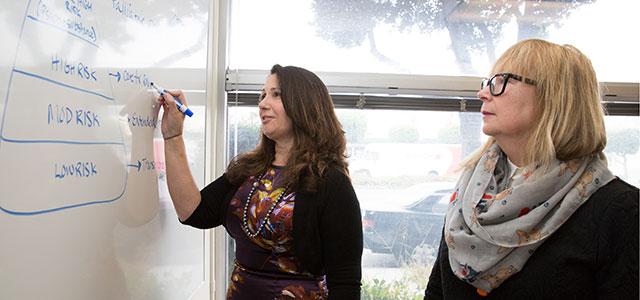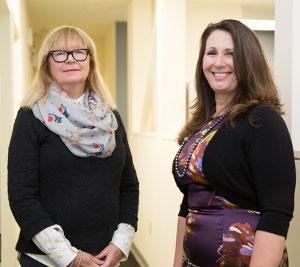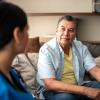
From left: Gina Intinarelli, executive director of the UCSF Office of Population Health and Accountable Care (OPHAC), and Carla Graf, OPHAC’s director of clinical programs (photo by Elisabeth Fall)
Tests of Change for Changing Times
Long before the Affordable Care Act passed in 2010, and certainly in the years since, experts around the country have understood that transforming the massive and complex US health care industry would be a bumpy road, characterized by trial and error, lots of trial and error.
“We’ve been identifying parts of our health system that are ripe for change and implementing innovative programs for the last five years,” says Gina Intinarelli (MS ’05, PhD ’13), executive director of the UCSF Office of Population Health and Accountable Care (OPHAC). “We can’t build programs fast enough.”
UCSF Health created OPHAC in 2015 to help amp up its response to the swirling forces driving health care change, especially the pressure on health systems to move away from fee-for-service and toward “value-based care,” which uses outcome-related incentives to foster a more efficient system, theoretically slowing cost increases while improving clinical outcomes and patient satisfaction. OPHAC has three primary components:
- Clinical programs focused on care delivery for vulnerable, high-risk populations
- Analytics aimed at analyzing and disseminating clinical and cost data
- A business office that facilitates relationships with regional partners to create accountable care organizations (ACOs), which are affiliations among doctors, hospitals and other health care providers – often in collaboration with payers – to provide coordinated care to patients
As executive director, Intinarelli draws on a 25-year UCSF career, which includes time as a critical care nurse, director of clinical operations for cardiothoracic surgery and director of Innovations in Population Health, OPHAC’s precursor program – as well as a PhD focused on health policy. She has no illusions about the challenges OPHAC faces, but says, “UCSF is making a real investment in reshaping itself for comprehensive payment reform. In addition to our own San Francisco-based ACO [in collaboration with One Medical Group and other community-based practices], we are creating affiliations in other parts of the Bay Area as well as our own health plan product.”
Such efforts can be thorny for an institution whose bread and butter has traditionally been high-volume, highly specialized inpatient procedures for complex patients. The reason? Both government and private payers are insisting that health systems move toward risk- or value-based contracts, which require that payment is at least partially based on how effectively systems avert unnecessary rehospitalizations or successfully optimize the health and minimize the costs of treating their entire patient population, especially those with chronic illnesses that are major cost drivers.
Yet no one expects change to occur overnight, hence the diverse experiments. At many academic medical centers, those experiments typically mean the health systems still receive fee-for-service payments but might also receive bonuses for reaching defined targets that are indicators of quality population health. This is known as “upside risk,” as opposed to true risk-based contracts, where payments for defined episodes of care or patient populations are capped and it’s up to the provider to effectively deliver care for that price.
“Most academic health centers are not at that stage,” says Intinarelli. She says OPHAC’s role is to find areas of the system that have the potential to move more aggressively in that direction and to assess what’s working, what’s not and what’s next.
Optimizing Transitional Care
In the current environment, with Medicare refusing payment for certain types of readmissions, optimizing care transitions from acute inpatient to various outpatient settings are often top of mind.
Carla Graf, who received her PhD in 2013 from UC San Francisco School of Nursing, with a focus on functional decline in older adults, is OPHAC’s director of clinical programs. Its initial foray into population health was an acute transitions program, which follows some patients who have been identified as high risk as they leave the hospital for either 30 or 90 days, depending on a number of different factors.
 “We needed to change the way we manage patients in the postdischarge period to better address their needs,” says Graf (at left, with Intinarelli). Today, OPHAC’s Care Transitions Outreach Program calls patients discharged to home within 72 hours after discharge. “The 48 to 72 hours after discharge is an especially vulnerable period,” says Graf. “Patients are well supported in the hospital. They are closely monitored and cared for by nurses, physicians, physical therapists and pharmacists, to name a few common hospital disciplines, and patients leave feeling confident they can handle their treatment plans and their new demands. But at home, the equipment might not look the same and they might find themselves confused or scared, or they might experience new or worsening symptoms and not know what to do. We needed to change the way we manage patients in the postdischarge period to better address their needs.”
“We needed to change the way we manage patients in the postdischarge period to better address their needs,” says Graf (at left, with Intinarelli). Today, OPHAC’s Care Transitions Outreach Program calls patients discharged to home within 72 hours after discharge. “The 48 to 72 hours after discharge is an especially vulnerable period,” says Graf. “Patients are well supported in the hospital. They are closely monitored and cared for by nurses, physicians, physical therapists and pharmacists, to name a few common hospital disciplines, and patients leave feeling confident they can handle their treatment plans and their new demands. But at home, the equipment might not look the same and they might find themselves confused or scared, or they might experience new or worsening symptoms and not know what to do. We needed to change the way we manage patients in the postdischarge period to better address their needs.”
The challenge is how to do so in an efficient and cost-effective way. OPHAC decided to begin by testing an automated telephone follow-up system.
Before patients leave the hospital, a nurse or patient navigator explains the system and emphasizes how important it is to answer the follow-up calls, which occur at regular intervals. When patients pick up the phone, they respond to a series of questions, which have been recorded in multiple languages. A complex algorithm then triages the patients based on their answers.
Patients who are doing well might have another automated check-in call scheduled for the following week. Those who identify a current need appear on the dashboard of a patient navigator or nurse, who completes a follow-up call and then can make referrals, convey information to outpatient care teams or simply answer questions and offer reassurance. The system creates efficiencies by allowing nurses to concentrate on clinical work appropriate to their training, while also collecting data that allows continual refinement.
“Patients have embraced it,” says Intinarelli, noting that at 90 days, 88 percent of patients appropriately pick up the phone, identify who they are and answer the questions.
For patients with a little more technological comfort, HealthLoop is a smartphone application that builds on the automated phone system by sending hip and knee surgery patients preprogrammed text messages – such as reminders and inspirational notes – which can begin as early as 45 days before surgery and continue throughout the postoperative period. The app also provides feedback to care providers, who can see patient responses on their dashboards and respond as necessary.
While it may be clear that patients are embracing the system, Graf says measuring the direct impact on outcomes like readmission rates can be tricky. “Readmissions are not sensitive to one thing,” she says. “We think the follow-up calls are the right thing to do, but we also have to make sure people have appropriate care at home, accessible medications, timely follow-up visits, care instructions in their own languages – all things we’ve put in place over the last few years.”
OPHAC is also hoping to expand the current home-based palliative care program in the coming year to include home-based transitional care for the most complex patients discharged from the hospital. “Some of these patients are not homebound but are still quite complex, and they may struggle to get back to see their provider right away after their hospital stay. This care in the home may prevent unnecessary ED [emergency department] visits or hospital readmissions until the patient is able to reconnect to the primary care practice,” says Graf.
Complex Care and Care Support
To address widespread concern about outpatients with multiple, complex chronic conditions driving up costs with preventable hospital stays and ED visits, OPHAC has instituted programs focused on three distinct populations.
One addresses complex primary care patients who are frequent users of emergency departments and/or inpatient care. A nurse practitioner or social worker leads an interdisciplinary care team that works closely with these patients’ primary care providers. “Patients in this program usually have multiple and comorbid chronic conditions and are willing to engage with us,” says Graf.
OPHAC and the UCSF Division of Geriatrics recently published a paper in PLoS ONE that studied one element of the program – the Geriatric Resources for the Assessment and Care of Elders (GRACE) program – and found that this type of management decreased acute care utilization and increased patient self-rated health in low-income seniors at community-based health centers. Such programs are especially important when one considers the aging population explosion in the US.
“It’s the right thing to do for patients and for the system.… And we’ve learned a lot in these efforts,” says Intinarelli.
A second complex care and care support program provides short-term care coordination for people who, perhaps, haven’t had health care for some time and who have multiple comorbid conditions. “We assign these patients to our health care navigation team, which works in partnership with the patient’s primary care provider to help them get acclimated to UCSF and get necessary tests and appointments scheduled,” says Graf.
The third and final such program has OPHAC working with primary care partners to better manage patients with uncontrolled chronic illnesses such as diabetes or hypertension. “We add value by screening patients for depression and anxiety, because it’s increasingly clear that those mental health challenges often accompany and exacerbate out-of-control chronic illness,” says Graf.
“Because we need to treat the psychiatric disorders as well as the physical conditions, we needed people with the skill set to do that,” says Intinarelli, which is where psychiatric/mental health nurse practitioners (PMHNPs) enter the picture.
Connecting Mental Health and Chronic Disease
In 2014, even before OPHAC was established, Intinarelli turned to PMHNP and faculty member Rosalind De Lisser to be the faculty psychiatric consultant to the clinical program teams. “Gina’s vision was to bring in a nursing faculty person, so there could be a scholarly approach to figuring out how best to integrate behavioral health,” says De Lisser of her constantly evolving position.
 Rosalind De Lisser (left) and Kara Birch At this point, her main role is to consult with primary care providers, so they can more successfully treat these complex patients. A second, related role is to work directly with patients for a short period of time to stabilize them and send them back to primary care. Typically, this happens when the provider refers a patient to De Lisser or to PMHNP and faculty member Kara Birch, who joined the team in 2016 and whose role is now similar to De Lisser’s. In these first two roles, De Lisser and Birch deliver an extra level of service and support that is not yet available in most primary care systems.
Rosalind De Lisser (left) and Kara Birch At this point, her main role is to consult with primary care providers, so they can more successfully treat these complex patients. A second, related role is to work directly with patients for a short period of time to stabilize them and send them back to primary care. Typically, this happens when the provider refers a patient to De Lisser or to PMHNP and faculty member Kara Birch, who joined the team in 2016 and whose role is now similar to De Lisser’s. In these first two roles, De Lisser and Birch deliver an extra level of service and support that is not yet available in most primary care systems.
A third role for De Lisser and Birch is helping other members of the team – social workers, health care navigators, family and adult nurse practitioners – understand how to manage, support and empower a patient population with behavioral health needs. “Working with these patients demands skills that are not necessarily part of other professions’ training,” says De Lisser.
“A fourth element is contributing to the systemwide need for primary care behavioral health integration,” says De Lisser. Other settings have demonstrated good results from such integrations, but this is not a one-size-fits-all proposition, so it demands study and testing of how to overcome the numerous clinical, financial and logistical challenges.
Finally, the faculty practice that De Lisser and Birch have created and grown provides an important training opportunity for PMHNP students.
Success Opens New Questions, New Challenges
The integration of PMHNPs into the population health effort has already yielded benefits, but it also underlines the complexity of both implementing and refining these ongoing experiments.
“Complex care support is doing this great work uncovering behavioral health needs, but finding the appropriate level of care and getting patients access to that care can be very challenging,” says De Lisser. Decisions need to be made about how much care is enough, how many touches a patient needs to get to the desired outcomes, and how and when to refer. There are no formulas.
In addition, says De Lisser, “We’ve found patients need more coaching and motivational work to even get them to the point where they’re willing to engage in self-care.”
She says one potentially cost-effective option is to offer peer-support groups that target symptom management for conditions such as depression and diabetes or congestive heart failure and anxiety. “Peer support is another untapped but powerful resource that can be used to engage people in their health behaviors, but it’s a resource that we currently are not leveraging,” says De Lisser.
Alternating Between Fatigue and Excitement
Navigating change to improve care can be exciting work, but some of the excitement is tempered by today’s unrelenting demands that new interventions be cost-effective and efficiently delivered, something that academic medical centers have not always needed to consider.
“For example, we adopted a model that uses NPs because of their exquisite skill sets in diagnosis and assessment, and their understanding of complex care,” says Intinarelli. “Yet it’s far too expensive for NPs to do it alone, so they also have to know how to leverage technology and understand the roles other caregivers can play to treat these populations. That’s a big challenge for us.”
It’s a challenge complicated by other elements of change that OPHAC must manage. There are the affiliations with other health care organizations throughout the Bay Area. There is the need to constantly integrate new technologies. It can begin to feel a bit overwhelming.
“We are in a constant state of innovation and learning.… And there is some change fatigue, especially when we realize that the biggest ills of society – poverty, housing, food access – roll up to the front door of health care,” says Intinarelli. “Big food, big pharma, big tobacco, the problems with public education – they’re all here, and we have to make some sense of where our boundaries are in care delivery. We’re in the early stages of our transition, but there’s no road map for how to do this.”
“It is a learning lab,” says Graf. “Every month that goes by we learn a little bit more, and at the end of day, this is about taking care of patients, and there is plenty for all of us to do.”



